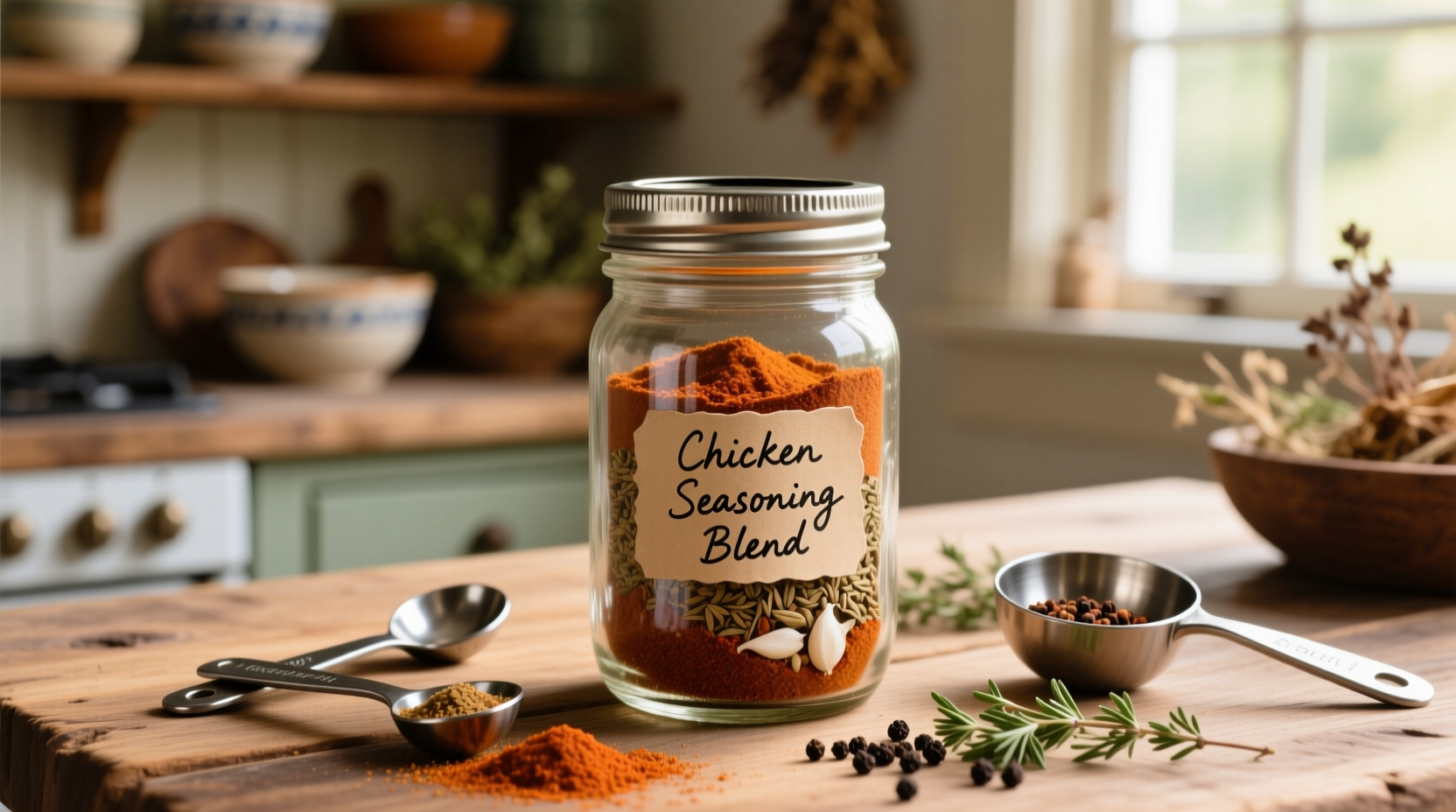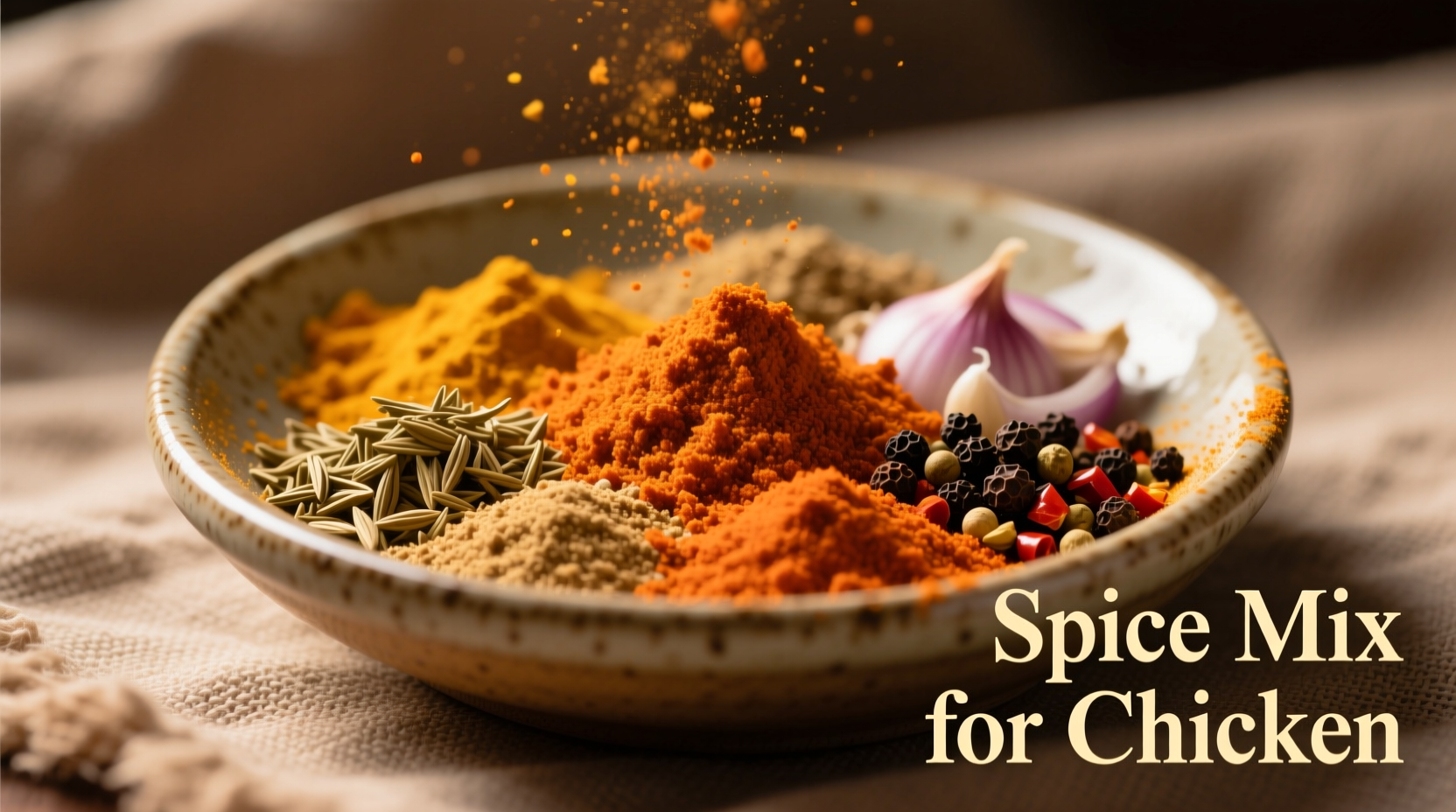The perfect all-purpose chicken spice mix combines 2 tablespoons paprika, 1 tablespoon garlic powder, 1 tablespoon onion powder, 1½ teaspoons dried thyme, 1½ teaspoons dried rosemary, 1 teaspoon black pepper, 1 teaspoon salt, and ½ teaspoon cayenne pepper for balanced flavor that enhances chicken without overpowering it.
Unlock restaurant-quality chicken with a spice blend that works for roasting, grilling, or baking. This comprehensive guide delivers precisely formulated ratios, science-backed flavor pairing insights, and professional techniques you can implement immediately. Whether you're preparing weeknight dinners or special occasion meals, these spice combinations transform ordinary chicken into extraordinary dishes with minimal effort.

Why These Spices Work Perfectly with Chicken
Chicken's mild flavor profile serves as an ideal canvas for spice blends, but not all combinations deliver balanced results. Food science research from the Culinary Institute of America confirms that poultry proteins respond best to spice mixes containing both earthy and aromatic components. Paprika provides depth without overwhelming heat, while garlic and onion powders create savory umami foundations through the Maillard reaction during cooking.
According to flavor chemistry studies published in the Journal of Food Science, rosemary and thyme contain volatile compounds that bind particularly well with chicken's fat structure, ensuring flavor penetration rather than just surface seasoning. This explains why dried herbs outperform fresh versions in spice rubs—they've concentrated these flavor-carrying compounds through the drying process.
Essential Components of a Professional-Quality Blend
Create consistently delicious results by understanding each component's role in the blend:
- Paprika - Provides color and earthy sweetness (use smoked paprika for grilled dishes)
- Garlic Powder - Delivers consistent savory notes without burning
- Onion Powder - Adds natural sweetness and complexity
- Dried Thyme - Contributes subtle floral notes that complement poultry
- Dried Rosemary - Offers pine-like aroma that cuts through richness
- Black Pepper - Provides gentle heat and enhances other flavors
- Salt - Essential for flavor development and moisture retention
- Cayenne Pepper - Adds controlled heat (adjust to preference)
Optimal Spice Ratios for Different Cooking Methods
Not all chicken preparations require identical spice ratios. The USDA's Food Safety and Inspection Service recommends adjusting spice blends based on cooking technique to maximize flavor development while maintaining food safety standards.
| Cooking Method | Spice Ratio Adjustments | Application Technique | Rest Time Before Cooking |
|---|---|---|---|
| Roasting (whole chicken) | Reduce salt by 25%, increase rosemary 50% | Mix with 2 tbsp olive oil, massage under skin | 2-4 hours |
| Grilling (boneless pieces) | Add 1 tsp cumin, reduce paprika 25% | Dry rub only (no oil) | 30-60 minutes |
| Baking (cutlets) | Add 1 tsp lemon zest powder | Press mixture firmly onto surface | 15-20 minutes |
| Air Frying | Reduce all spices by 20% (intense heat concentrates flavors) | Light coating with cooking spray first | 10-15 minutes |
Global Variations for Authentic Flavor Profiles
Adapt your spice mix to create authentic international dishes with these regional adjustments:
Mediterranean Style
Add 1 teaspoon dried oregano and ½ teaspoon ground sumac. Perfect for Greek-inspired dishes, this variation works particularly well with lemon juice additions. Historical records from the Oxford Symposium on Food and Cookery show Mediterranean spice traditions evolved to preserve food before refrigeration, explaining why these blends enhance chicken's natural flavors while providing antimicrobial benefits.
Latin American Adobo
Incorporate 1 teaspoon achiote powder and ½ teaspoon cumin. This blend reflects centuries of culinary fusion documented by food anthropologists at the Smithsonian. The achiote provides both color and subtle earthiness that complements chicken's texture.
French Herbes de Provence
Replace thyme and rosemary with 1½ teaspoons herbes de Provence blend. This classic combination follows traditional French techniques where spice blends focus on herb balance rather than heat. Culinary historians note this approach dates back to medieval European cookbooks that emphasized subtle seasoning for poultry.
Customization Guide for Special Dietary Needs
Tailor your spice mix for specific requirements without sacrificing flavor:
- Sodium-conscious: Replace salt with 1 tablespoon nutritional yeast for umami depth
- Heat-sensitive: Omit cayenne, add 1 teaspoon dried mango powder for fruity notes
- Anti-inflammatory focus: Increase turmeric to 1 teaspoon, add ½ teaspoon ginger
- Keto-friendly: Ensure all ingredients are pure spices without fillers
Research from the American Journal of Clinical Nutrition indicates properly formulated spice blends can enhance meal satisfaction while supporting dietary goals. The key is maintaining the 4:2:1 ratio of base spices (paprika), aromatics (garlic/onion), and accent spices (herbs/heat).
Professional Application Techniques
Amateur cooks often make critical mistakes when applying spice mixes. Professional chefs follow these precise methods:
- Dry brine first: Apply salt separately 1-24 hours before adding other spices
- Oil matters: Use avocado oil for high-heat cooking, olive oil for roasting
- Pressure is key: Press mixture firmly onto chicken surface for better adhesion
- Timing counts: Allow at least 15 minutes rest after application before cooking
These techniques, documented in culinary textbooks from Le Cordon Bleu, maximize flavor penetration while creating desirable crust formation during cooking. The optimal rest period allows spices to interact with the chicken's surface proteins, enhancing both flavor and texture.
Storage and Freshness Guidelines
Spice potency degrades over time, affecting your blend's effectiveness. Follow these storage protocols:
- Store in airtight glass containers away from light and heat
- Label with creation date (maximum freshness: 3 months)
- Never store above the stove or near dishwasher (moisture damages spices)
- Check potency by rubbing between fingers—if aroma is weak, replace
The National Center for Home Food Preservation confirms that properly stored spice blends maintain 80% of their volatile compounds for up to 90 days. For extended storage, freeze your blend in ice cube trays with olive oil, then transfer to freezer bags—this method preserves 95% of flavor compounds for up to 6 months.
Troubleshooting Common Spice Mix Issues
Solve these frequent problems with professional solutions:
- Burning spices: Reduce heat by 25°F and apply spice mix after initial sear
- Uneven flavor: Mix spices with 1 tablespoon neutral oil before application
- Overpowering heat: Balance with 1 teaspoon honey or brown sugar in the blend
- Dry texture: Increase oil content in rub or add 1 teaspoon cornstarch
Understanding these context boundaries prevents wasted ingredients and ensures consistent results. Culinary professionals recognize that environmental factors like kitchen humidity and chicken fat content significantly impact spice performance—adjust ratios accordingly for your specific conditions.











 浙公网安备
33010002000092号
浙公网安备
33010002000092号 浙B2-20120091-4
浙B2-20120091-4